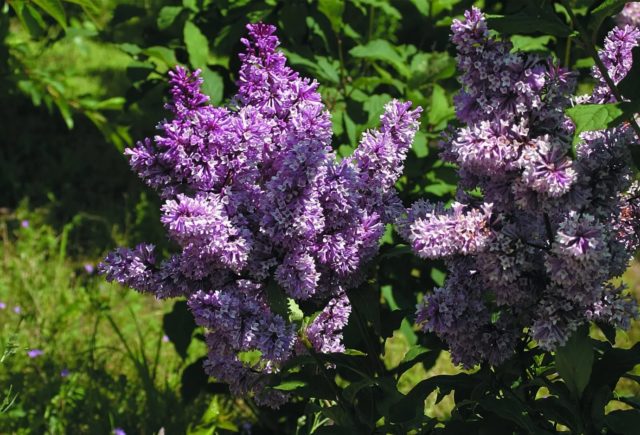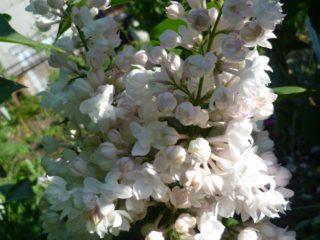Content
Hungarian lilac is a fragrant shrub that fascinates with its excellent and abundant flowering. Lilac is used in both rural and urban plantings because it is unpretentious and has a long flowering period.
General description of the variety
Hungarian lilac (Syringa josikaea) is the second most common shrub after the common lilac, which has a dense foliage crown that forms an egg shape. An adult representative of the Hungarian lilac can grow up to 400 cm in height; with proper care and timely fertilization, the crown diameter of the Hungarian lilac reaches the same size.
The leaves of the Hungarian lilac are made in the shape of an ellipse, their size varies from 6 to 12 cm in length. From the end of autumn and throughout the summer, the foliage is painted in a rich dark green color, with the onset of cold weather the color changes to yellow.The most beautiful period is the flowering of the graceful shrub.
How Hungarian lilac blooms
When lilac flowers bloom, the shrub looks like a tree showered with flowers. The size of each flower is no more than 1 cm, the color is purple, the inflorescence looks like a pyramidal model. The flowering time of Hungarian lilac differs from the flowering period of ordinary lilac: the former blooms its buds 2 - 3 weeks later and pleases with them for up to 25 - 30 days.
Forms and varieties of Hungarian lilac
Most of the lilac varieties were bred on the basis of the common variety. Hungarian does not have a variety of varieties; only a few of its forms exist in horticultural culture.
- pale form - has a soft lilac color, which seems a little faded in the sun;
- red-flowered form - its color is bright purple, iridescent in a red tint;
- white-flowered – Hungarian white lilac;
- Rosaceae.
How does Hungarian lilac reproduce?
A distinctive feature of the Hungarian lilac is that it does not produce suckers. In this regard, some difficulties arise with the propagation of shrubs.
The main method is cuttings. Not only green twigs, but also lignified ones are suitable as propagation material. If you approach propagation responsibly, the seedlings will quickly take root.
Another method of propagation is by seed. A prerequisite is stratification. In its process, the winter period is simulated for 2 months, keeping the seed material in the refrigerator. Seed sowing is carried out in autumn or spring. With careful care, germination reaches 70%, which is slightly lower than when propagated by cuttings.
Planting and caring for Hungarian lilacs
Like any other tree, Hungarian lilac can grow only with proper care. To create favorable growth conditions, it is necessary to take into account all factors - planting rules, soil preparation, etc.
Recommended timing
Planting of Hungarian lilac can be done both in spring and in autumn. If you plant seedlings from mid-July to the end of August, you can expect active growth of the bush in the very first season.
It is not worth planting the crop in early spring and autumn, since at this time the soil contains a lot of moisture, which has a detrimental effect on the condition of the plant. Young roots may rot or significantly slow down their growth.
Site selection and soil preparation
Common Hungarian lilac loves sunlight. Therefore, when choosing a landing site, it is worth taking this factor into account. The area for planting seedlings should be well lit, but closed from winds and drafts, which have a detrimental effect on the bush.
“Hungarian” is not picky about soil, but it is not worth planting in waterlogged or clayey substrates. The roots of the bush quickly rot from excess moisture, which leads to their death. It is best to choose an area with fertile soil that is well drained. The composition of the soil can be either neutral or slightly acidic.
Under favorable conditions, the Hungarian lilac (in Latin Syringa josikaea) can live at least 100 years. During its lifetime, it manages to bloom at least 90 times.
How to plant correctly
In order for lilacs to take root well and grow unhindered, it is necessary to take into account the basic planting rules:
- the distance between seedlings should be, on average, 2.5 meters;
- planting holes must have steep walls;
- a substrate must be added to each hole, which contains components such as compost, humus, superphosphate (if additional acidification of the soil is necessary) and wood ash.
Procedure:
- The substrate (its components) must be thoroughly mixed and a small part poured into the planting hole.
- The crown of seedlings should be shortened: depending on the height of the planting material, up to 3 buds are removed.
- If the roots of the seedling are too long, they can also be trimmed a little. Ideally, the length of the roots should be no more than 30 cm.
- The seedling must be placed in the center of the created recess.
- Straighten all the roots.
- Sprinkle with the remaining substrate and tamp down a little.
- Water generously.
Care and cultivation of Hungarian lilac
Hungarian lilac is undemanding to care. However, it is important to follow the basic rules of agricultural technology.
Watering schedule
Immediately after planting, the lilacs are shed with 20 liters of water. After 1 - 2 weeks (when planting in mid-summer), the bush is again shed with the same amount of water. After rooting, the shrub needs infrequent watering, since the plant receives sufficient moisture from the soil after precipitation. During the dry period, you can occasionally water the shrub, avoiding stagnation of water in the root system.
After each watering, it is necessary to loosen the soil near the roots so that they can breathe unhindered.
What can you feed?
The first two years after planting, lilacs need only one substance - nitrogen. Therefore, the addition of ammonium nitrate or urea is recommended. After rooting, the bushes are fed with a manure solution (5 parts water and 1 part manure). The composition cannot be poured directly under the trunk; it is better to distribute it within a radius of half a meter from the bush. Otherwise, the roots will begin to rot and the plant will die.
In autumn, lilac bushes need phosphorus and potassium fertilizers. Therefore, it is recommended to fertilize the plant with wood ash diluted in water (400 g per 15 l), potassium nitrate or superphosphates.
Mulching the soil
Mulching the soil is carried out immediately after planting the seedling. To do this, you can use rotted leaves or manure. First, a layer of mulch up to 7 cm is laid, after the first watering the mulch is replenished with another 2-3 cm layer.
Pruning Hungarian lilac
The leaves of the Hungarian lilac themselves are very beautiful and form a graceful shrub shape. Therefore, the shrub does not need additional manipulations. Trimming is carried out only if it is necessary to create a more elegant silhouette.
The process is quite simple, which is due to the ability of lilac branches to maintain a given “course” of growth. It is enough to cut the branches at the required slope once in the spring, when active gardening has not yet begun, and the shrub will retain its shape until the next season.
Preparing the bush for winter
Despite their unpretentiousness, young shrubs still need to organize winter shelter for the root system. To do this, use dry leaves or peat. With the onset of the first cold weather, it is necessary to fill the tree trunk space with the selected material; the covering layer should be within 10 - 15 cm. After the bush has grown (after about 2 - 3 years), the lilac does not need to be prepared for winter.
Application in landscape design
The blooming of Hungarian lilac is a real decoration of any area. Shrubs are planted along hedges, at the entrance to the garden, near the house and gazebos. The versatility of using lilac in landscape design was also noted by professional designers, who suggest not only planting the plant in any convenient area, but also creating real compositions with its help.
Hungarian lilac can act as a hedge, acting as a real fence for a garden plot. To properly form a hedge, you need to take into account not only the size of the seedling at the time of planting, but also what volume the adult plant will reach. Therefore, it is necessary to allocate a sufficiently large area of land for shrubs in order to ultimately obtain the desired result.
Rules for organizing a fence:
- Plant the seedlings in holes, the distance between which should be 1.5 meters.
- To ensure that the bush grows evenly, it should not be fertilized or pruned for the first 3 years.
- Feeding begins in the 4th year of life.
- No watering is required: moisture will be sufficient from melting snow and rain.
- Pruning is carried out only to renew bare bushes.But there should always be at least 10 strong shoots per plant.
The standard form is also one of the options for planting lilacs. It is a little more complicated than organizing a hedge, but it has its aesthetic advantages.
To create a decorative standard, you need to take an ungrafted lilac. It is necessary to select one suitable shoot that has a height of at least 1 meter (the procedure is carried out in the spring). The roots of the plant should be cut so that a square measuring 20 by 20 centimeters is obtained. A varietal lilac (Hungarian) must be grafted onto the selected cuttings, and in the autumn the bush must be dug up and planted in a prepared area. All root growth must be removed.
Hungarian lilac can be planted in an area with other plants. The most favorable neighbors are considered to be: tree peony, viburnum, lupins, hydrangea, phlox, spruce and other conifers, perennial shrubs and evergreens.
The crop can be planted:
- in one group with bushes;
- in sirengarias (when a planting is organized consisting of varietal and species lilacs, which replace each other with a flowering period and differ in flower color);
- on flowerbeds of various sizes;
- in arrays;
- in discounts;
- for vertical accentuation of beautifully blooming compositions.
Pests and diseases of Hungarian lilac
Despite its ease of care, Hungarian lilac still suffers from a number of pests and diseases. Being in open ground, the plant is in wait for enemies such as mites, moths and scale insects.All of them are capable of causing irreparable harm to the bush, which can be fatal for it. Therefore, it is worth treating lilacs in a timely manner with special preparations purchased in the store. If the pests have already damaged parts of the plant, then the affected branches and foliage must be cut off and burned.
Diseases include fungal phyllostictosis, viral mosaic and spotting. All these pathologies require immediate treatment with specialized drugs. Otherwise, other plants on the site may also suffer.
Conclusion
Hungarian lilac does not require special care, is an excellent decoration for any area, and can also be used as a hedge. For a shrub to delight you with its flowering, you just need to make some efforts and provide it with comfortable growing conditions.
Reviews
















